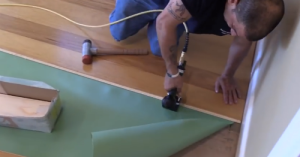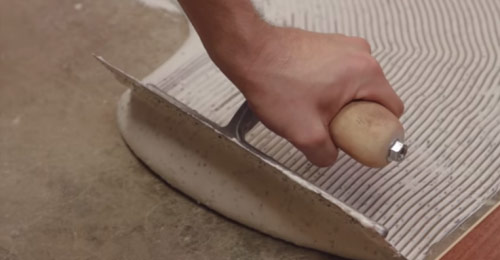2-1/4″ planks were once the standard in residential hardwood flooring, but planks that are 5 inches wide and above are popping up all over residential and commercial settings alike. You’ll find that the installation process is a bit different from working with floors under 5 inches wide.
Wide plank floors are growing in popularity, so you should be prepared to perform this type of installation.
In case you get a request to install wide plank flooring for a client and you’re worried about the differences between wide planks and thinner planks, we’ve compiled some tips.
How to Install Wide Plank Flooring
It is especially important to ensure fasten the planks correctly when installing wide plank floors. Plain sawn wide plank floors are more prone to moving in response to relative humidity changes, so you have to be extra careful when installing this type of flooring. Fastening these floors securely often
 entails using adhesive in addition to nails, even if you’re installing a solid wide plank floor.
entails using adhesive in addition to nails, even if you’re installing a solid wide plank floor.
When installing solid wide plank floors over a plywood subfloor, the best method is to apply adhesive to the floorboards, blind nail the length of the boards with a pneumatic nailer, and face nail when you reach the end of a board.
Make sure to leave a 1/4″ gap between the floorboards and end walls to allow for seasonal dimensional growth so the wood can expand without cupping.
When installing solid wide plank over a concrete slab, only adhesive is used to secure the flooring. It will benefit you to use an adhesive that has a moisture vapor barrier incorporated into the formulation, to keep out any moisture that will seep through the concrete.
Always be aware of the species and milling of the plank floor so you can avoid potential problems. For example, plain sawn hickory is a lot less stable than a quarter sawn American cherry, so it would be better to install cherry in an environment that is subject to significant fluctuations in humidity throughout the year.
Acclimation and moisture measurements
With wide plank flooring, acclimation and moisture measurements are especially important to perform correctly because wide planks are more prone to noticeable cupping and gapping than thinner planks.
Make sure to take accurate readings of the moisture content in the floor planks and subfloor to ensure that conditions are ideal for installation.

If you install wide planks when the moisture content and relative humidity levels aren’t right, you’ll be in for a cupping-gapping-squeaking call back.
Installing wide planks in humid areas? Yes, it can be done. In these situations, it’s often necessary to peg the floors to prevent cupping. Make sure that your subfloor is able to handle the extra moisture. A problematic subfloor will lead to a problem in the floor itself down the road. Most adhesive companies require a relative humidity level of the concrete slab of 85%. Be sure to learn the newest method (Insitu) for measuring relative humidity.
Just as with thinner flooring, you run a risk installing solid wide plank floors in below-grade environments, like basements and garages. But you can safely install engineered wide plank floors in below-grade environments.
Educating your clients about their wide plank floors
As with all things, education is the key to preventing problems down the line. Although your client may have really wanted wide plank floors installed in their home, they may not understand the possible complications involved with this type of flooring.
Education should be a constant process. Before, during, and after the installation, let your clients know how to care for their floors, and what to expect a few months down the line.
Let them know that wide plank flooring is more prone to movement than thinner floors, and that they might experience noticeable gapping during the colder months, particularly in areas where forced hot air heating systems are commonplace. Educate them about proper relative humidity levels, and the steps they can take to maintain the optimal level of moisture content in their home.
It would a good idea to see your clients off with a floor care guide tailored specifically with information about wide plank floors. Read more about crafting the perfect floor care guides for your clients.
Conclusion
Installing wide plank floors might seem daunting if you’ve never done it before. But if you arrive at the jobsite prepared with this knowledge and you perform to the best of your abilities, you’ll end up with a fantastic wide plank installation to make you proud for years to come.
